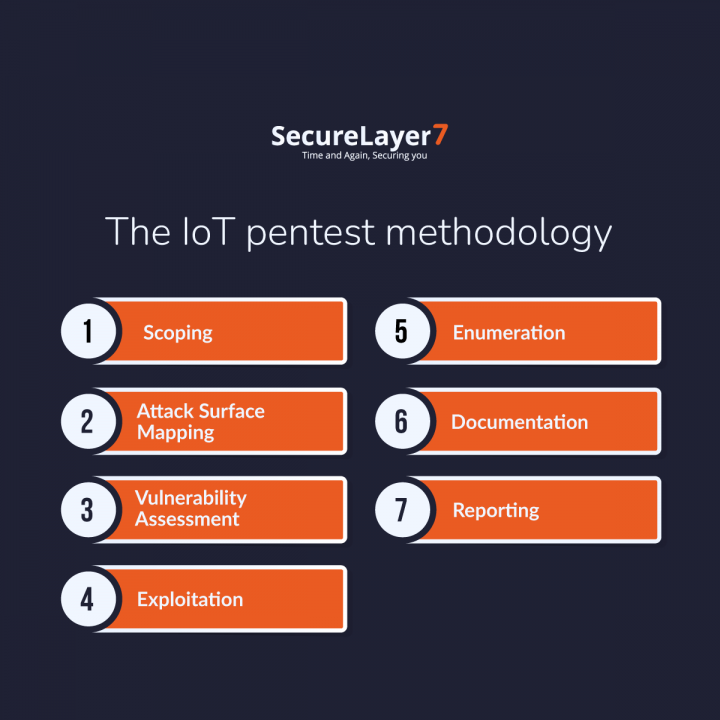
The Benefits of Penetration Testing for Early-Stage Startups
June 1, 2023
5 Cybersecurity Mistakes Startups Make & How to Avoid Them
June 7, 2023
The Internet of Things (IoT) has revolutionized the way we interact with the world around us. From smart homes and cities to industrial automation and healthcare, IoT devices are everywhere.
While these devices provide convenience and efficiency, they also pose significant security risks. Cyber attacks on IoT devices can result in data breaches, privacy violations, and even physical harm.
To mitigate these risks, it’s essential to perform IoT penetration testing. Penetration testing is a simulated cyber attack that aims to identify vulnerabilities in an IoT device or network.
Through penetration testing, organizations can identify weaknesses in their security controls and implement remediation strategies before a real attack occurs.
In this blog, we will cover each aspect related to IoT penetration testing. We will discover all the important measures to be taken while pen testing for IoT devices. But before that let us reflect some light on IoT for the best understanding.
Let us get started with knowing all about IoT pen testing.
What is IoT?
IoT stands for the Internet of Things, and it refers to the network of physical devices, vehicles, home appliances, and other items embedded with electronics, software, sensors, and connectivity that enables them to connect and exchange data with other devices and systems over the internet.
IoT technology has grown rapidly in recent years and has the potential to revolutionize the way we live and work.
IoT offers many useful benefits that can improve our daily lives. Here are some instances.
- Smart homes: IoT devices can be integrated into homes to make them more energy-efficient and convenient. Smart thermostats, for instance, can adjust heating and cooling automatically based on the occupants’ habits, saving energy and reducing costs. Smart lighting systems can be controlled remotely and programmed to turn off when no one is in the room, also saving energy.
- Healthcare: IoT devices can improve patient care by allowing doctors and caregivers to monitor patients remotely. Wearable devices, for example, can track patients’ vital signs and alert caregivers if there are any concerns. IoT technology can also enable remote consultations, saving time and money for patients and providers.
- Industrial automation: IoT devices can be used to automate industrial processes, such as manufacturing and logistics. Sensors can be placed on machines to monitor their performance and detect issues before they become costly problems. IoT technology can also optimize supply chains, reducing waste and improving efficiency.
- Agriculture: IoT devices can be used to monitor crop growth, soil moisture, and weather conditions, helping farmers make informed decisions about when to plant, water, and harvest crops. IoT technology can also help reduce waste by monitoring and optimizing resource usage, such as water and fertilizer.
However, is IoT Secure?

The security of IoT (Internet of Things) is a complex and multifaceted issue that requires attention from various angles. The interconnected nature of IoT devices means that they can potentially be vulnerable to security threats such as hacking, malware, and data breaches.
There have been several incidents that have raised questions about the security of technology and have left end users apprehensive.
Some Famous Security Hacks in the Past
There have been several high-profile IoT hacks in the past. Here are some examples:
- Mirai Botnet: In 2016, the Mirai botnet infected hundreds of thousands of IoT devices, including cameras, routers, and digital video recorders. The botnet was used to launch distributed denial of service (DDoS) attacks, which caused widespread disruption to internet services.
- Jeep Cherokee hack: In 2015, security researchers demonstrated that it was possible to remotely hack into a Jeep Cherokee through its internet-connected entertainment system. The researchers were able to take control of the car’s brakes, transmission, and other systems, highlighting the potential dangers of insecure IoT devices in critical systems.
- Smart home locks: In 2016, researchers discovered a vulnerability in a range of smart home locks that allowed an attacker to unlock the doors remotely. The vulnerability was caused by a flaw in the communication protocol used by the locks.
- St. Jude Medical pacemaker hack: In 2017, security researchers discovered vulnerabilities in pacemakers manufactured by St. Jude Medical. The vulnerabilities could be exploited to remotely control the pacemakers and cause potentially life-threatening malfunctions.
- Baby monitor hack: In 2013, a couple in Houston, Texas, reported that their baby monitor had been hacked, and a stranger had been watching and talking to their baby through the monitor. The hack was made possible by the fact that the monitor was not properly secured.
These hacks demonstrate the potential risks associated with insecure IoT devices and the importance of implementing proper security measures to protect against them.
What is IoT Pentesting?
IoT pentesting is a critical component of ensuring the security of Internet of Things (IoT) devices and systems.
With the increasing number of connected devices, it is essential to identify potential vulnerabilities and weaknesses that could be exploited by attackers.
IoT pen-testing involves a systematic approach to assessing the security of IoT devices and systems by identifying potential threats, vulnerabilities, and exploits.
By performing IoT pen-testing, security professionals can simulate real-world attack scenarios and identify gaps in security defenses, ultimately leading to improved security measures to protect IoT devices and systems.
OWASP Top 10 for IoT Pentest
OWASP (Open Web Application Security Project) is a nonprofit organization focused on improving the security of software. OWASP maintains a list of the top 10 security risks for web applications, which is widely used by security professionals to prioritize their testing efforts.
Recently, OWASP has also published a Top 10 list specifically for IoT pen-testing. This list enumerates the most critical IoT security risks and vulnerabilities that should be covered as a part of IoT pen testing.
The significance of the OWASP Top 10 for IoT pentest is that it provides a standard framework for assessing the security of IoT devices and systems. By following the Top 10 list, security professionals can ensure that they cover the most significant security risks and vulnerabilities for IoT devices.
This can help you ensure that devices and systems are secure and resistant to attack.
Make a listicle of all these test cases mentioned below
The OWASP Top 10 for IoT pentest includes the following test cases.
- Weak, guessable, or hardcoded passwords – Passwords that are weak, easy to guess, or hardcoded should be identified during testing in order to prevent attackers from taking advantage of them.
- Insecure network services – Identifying vulnerabilities in network services utilized by IoT devices, such as inadequate encryption, inappropriate use of transport layer security (TLS), and susceptibility to man-in-the-middle (MITM) attacks, should be part of testing.
- Insecure ecosystem interfaces – Vulnerabilities in interfaces used to connect with other systems or devices, such as APIs, web interfaces, and other network interfaces, should be identified during testing.
- Lack of secure update mechanism – Testing should involve evaluating the security of the update method used to update IoT devices, such as whether updates are signed and validated, as well as the update process itself.
- Use of insecure or outdated components – Identifying IoT devices with known vulnerable or obsolete components, such as operating systems or third-party libraries, should be part of the testing process.
- Insufficient privacy protection – Detecting IoT devices that collect and store personal information, as well as verifying whether that data is securely protected from unauthorized access, should be included in the testing process.
- Insecure data transfer and storage – Finding that the IoT devices collect and store personal information, as well as verifying whether that data is securely protected from unauthorized access, should be included in the testing process.
- Lack of device management – Identifying IoT devices that do not provide proper management capabilities, such as the ability to monitor and regulate access to the device, should be part of the testing process.
- Insecure default settings – Identifying IoT devices with unsafe default settings, such as default passwords or open network services, should be part of the testing process.
- Lack of physical hardening – Testing should include assessing the physical security of IoT devices and systems, including weaknesses in tamper resistance and environmental protections.
The IoT pentest methodology
Here are the different stages of the IoT pen test methodology at a glance. Let’s take a closer look at them.

1. Scoping
The first step in the IoT pentest methodology is scoping. Scoping is an important process that helps to define the scope of the IoT pentest, including the devices and systems that will be tested, the objectives of the test, and any specific requirements or constraints.
During the scoping phase, the pentester will typically work closely with the client to gather information about the IoT devices and systems that are being tested.
This can include details such as the types of devices being tested, the network topology, the protocols and interfaces being used, and any other relevant information.
Based on this information, the pentester can then define the scope of the IoT pentest, including which devices and systems will be tested, the types of attacks that will be simulated, and any other specific requirements or constraints.
2. Attack Surface Mapping
The second step in the IoT pentest methodology is attack surface mapping. Attack surface mapping involves identifying the various entry points and interfaces that an attacker could use to gain access to the IoT devices and systems being tested.
During the attack surface mapping phase, the pentester will typically use a range of techniques and tools to identify the different interfaces and entry points that are available for IoT devices and systems. This can include network interfaces, APIs, mobile apps, and other interfaces.
The objective of the attack surface mapping phase is to gain a comprehensive understanding of the different ways in which an attacker could potentially gain access to the IoT devices and systems being tested.
This information is then used to inform the vulnerability assessment and exploitation phases of the pentest.
3. Vulnerability Assessment
Vulnerability assessment is a critical component of IoT (Internet of Things) pen-testing, as it involves identifying and evaluating the vulnerabilities in the IoT devices and their associated networks.
This typically involves using a combination of automated tools and manual testing techniques to identify security weaknesses that could be exploited by attackers.
In IoT pen-testing, vulnerability assessment can be challenging due to the large number and diversity of IoT devices, many of which have limited processing power and memory.
However, some common vulnerabilities that are often found in IoT devices include:
- Weak or default passwords: Many IoT devices come with default usernames and passwords that are easily guessable or widely known, making them vulnerable to brute-force attacks.
- Unsecured communication: Many IoT devices use insecure communication protocols that do not encrypt data, making them vulnerable to interception and tampering.
- Outdated software: IoT devices often run on outdated or unpatched software, leaving them vulnerable to known exploits and vulnerabilities.
- Lack of access controls: Some IoT devices do not implement proper access controls, allowing unauthorized users to access and manipulate the device.
To conduct a vulnerability assessment in IoT pentesting, pen-testers typically use a combination of tools such as network scanners, port scanners, vulnerability scanners, and exploit frameworks.
Manual testing techniques such as password cracking, packet sniffing, and reverse engineering can also be used to identify vulnerabilities that may not be detected by automated tools.
The results of the vulnerability assessment are then used to prioritize vulnerabilities based on their severity and potential impact and to provide recommendations for remediation.
Remediation may involve applying patches, updating software, changing default passwords, and implementing access controls, among other things.
4. Exploitation
In IoT pen testing, exploitation can be challenging due to the diversity of IoT devices and their associated networks. However, some common techniques that can be used to exploit vulnerabilities in IoT devices include:
- Brute force attacks: Brute force attacks involve attempting to guess usernames and passwords to gain access to devices or networks. This is often successful if the devices or networks use weak or default passwords.
- SQL injection: SQL injection involves inserting malicious SQL code into a web application that uses a backend SQL database. This can be used to extract sensitive data or gain unauthorized access to the database.
- Remote code execution: Remote code execution involves executing malicious code on a device or network remotely. This can be done by exploiting vulnerabilities in software or firmware that the device or network uses.
- Man-in-the-middle attacks: Man-in-the-middle attacks involve intercepting and manipulating data between two parties. This can be used to steal sensitive data or manipulate the behavior of the devices or networks.
Once a vulnerability has been successfully uncovered, pen testers can use this access to demonstrate the potential impact of the vulnerability. This can involve stealing sensitive data, manipulating device behavior, or launching additional attacks.
5. Enumeration
In IoT pen testing, enumeration can be challenging due to the large number and diversity of IoT devices and their associated networks. However, some common techniques that can be used to enumerate IoT devices and networks include:
- Network scanning: Network scanning involves scanning the network to identify the devices connected to it. This can be done using tools such as Nmap or Netcat.
- Service identification: Service identification involves identifying the services and applications running on the devices. This can be done by analyzing the ports and protocols used by the devices and performing banner grabbing.
- Protocol analysis: Protocol analysis involves analyzing the communication protocols used by the devices and networks. This can be done by capturing and analyzing network traffic.
- Device fingerprinting: Device fingerprinting involves identifying the make and model of the devices connected to the network. This can be done by analyzing the responses to specific requests and commands.
Once the devices and networks have been enumerated, pen testers can use this information to identify potential attack vectors and weaknesses. This can involve identifying vulnerabilities in the devices or networks or identifying potential entry points for exploitation.
6. Documentation
Documentation is a critical component of the IoT pen testing process, as it provides a clear record of the testing methodology, results, and recommendations for remediation.
By documenting the testing process and its findings, pen testers can help to ensure that the devices and networks are secure and that the risks to the organization are minimized.
7. Reporting
Reporting is an essential component of any IoT (Internet of Things) pen testing process, as it communicates the findings and recommendations of the testing process to stakeholders.
The goal of reporting is to provide clear and actionable information that enables the device owners to understand the risks and take steps to mitigate them.
In IoT pen testing, reporting typically includes the following components.
- Executive summary: The executive summary provides a high-level overview of the testing process, the findings, and the recommendations. This section is typically targeted at senior management and should be concise and easy to understand.
- Findings: The findings section provides a detailed description of the vulnerabilities and risks that were identified during the testing process. This section should include the severity and potential impact of each vulnerability, along with evidence to support the findings.
- Recommendations: The recommendations section guides how the vulnerabilities and risks can be mitigated or eliminated. This section should be specific, actionable, and prioritized based on the severity and potential impact of each vulnerability.
- Appendices: The appendices section includes additional information that supports the findings and recommendations, such as screenshots, logs, and other relevant data.
The report should be clear, concise, and easy to understand, with a focus on actionable recommendations. The report should also be reviewed and approved by all relevant stakeholders, including the device owners, IT staff, and management.
Secure your IoT with SecureLayer7’s comprehensive pentest
SecureLayer7 offers comprehensive IoT (Internet of Things) pentest services to help organizations identify vulnerabilities and secure their IoT devices and networks.
Our expert team uses a variety of advanced techniques and tools to simulate real-world attacks and identify potential weaknesses, providing a detailed report that includes actionable recommendations for remediation.
With our IoT pentest services, organizations can ensure that their devices and networks are secure and that the risks to their business are minimized.
Contact us today to learn more about how we can help secure your IoT.